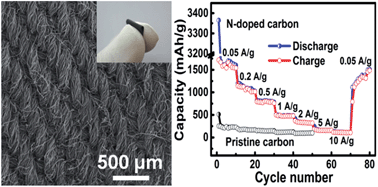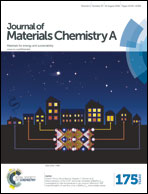Three-dimensional porous graphene-like carbon cloth from cotton as a free-standing lithium-ion battery anode†
Abstract
Most of the carbon-based anodes have been reported to exhibit relatively low capacity due to the lack of superior electrical conductivity, mechanical flexibility and high electrochemical stability. Here, we report a new and simple approach to fabricate N-doped porous graphene-like carbon cloth from cotton cloth by using chemical vapor deposition. The N-doped carbon cloth has a unique macroscopic hierarchical structure of few-layer graphene and a super-high specific surface area of 1890 m2 g−1, and exhibits outstanding mechanical and electrical characteristics. This free-standing carbon-based cloth is desirable to be an anode material in high power and energy density lithium ion batteries (LIBs). The N-doped carbon cloth shows a reversible capacity of 1485 mA h g−1 at a current density of 50 mA g−1 after 80 charge–discharge cycles, which is nearly four times the theoretical capacity of graphite. More importantly, a very high capacity of ∼500 mA h g−1 is obtained at 1.0 A g−1, and fades less than 5% after 200 cycles, exhibiting excellent high-rate performance and long-term cycling stability. The N-doped carbon cloth is a superior flexible LIB anode to other carbon-based materials due to the good combination of its hierarchical and porous structure, large surface area, high electrical conductivity and excellent mechanical stability.


 Please wait while we load your content...
Please wait while we load your content...